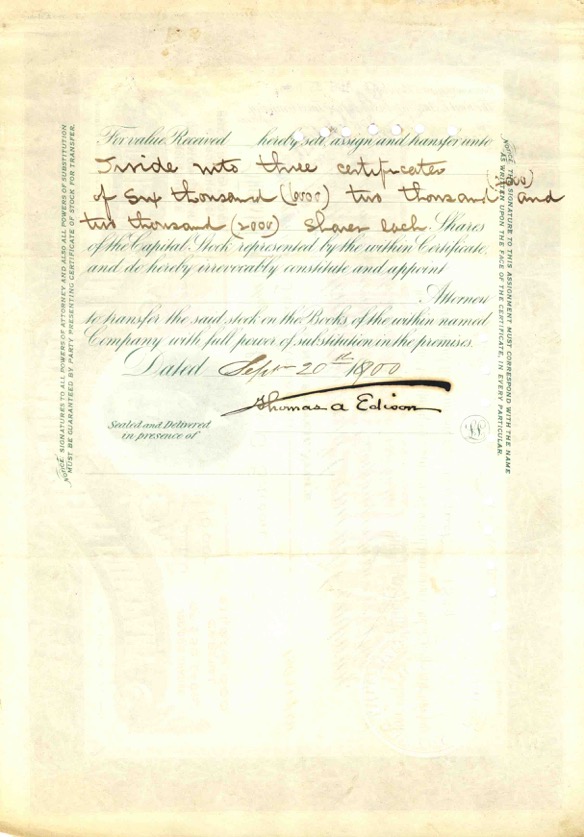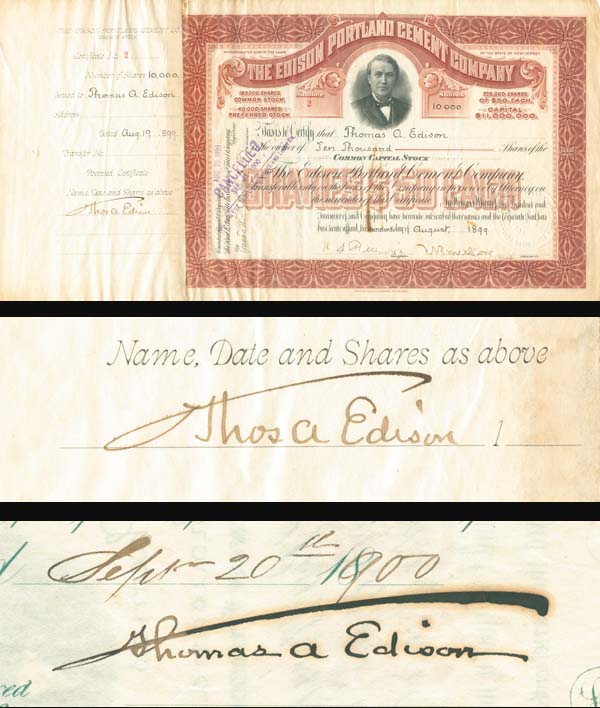Edison Portland Cement Co. signed twice by Edison - Stock Certificate
Inv# AG1404 Stock
Certificate #2 stock signed twice by Thomas A. Edison. Two great signatures at stub and back. Exceptional!
Thomas Alva Edison (February 11, 1847 – October 18, 1931) was an American inventor, scientist and businessman who developed many devices that greatly influenced life around the world, including the phonograph, the motion picture camera, and a long-lasting, practical electric light bulb. Dubbed "The Wizard of Menlo Park" (now Edison, New Jersey) by a newspaper reporter, he was one of the first inventors to apply the principles of mass production and large teamwork to the process of invention, and therefore is often credited with the creation of the first industrial research laboratory. Edison is considered one of the most prolific inventors in history, holding 1,093 U.S. patents in his name, as well as many patents in the United Kingdom, France, and Germany. He is credited with numerous inventions that contributed to mass communication and, in particular, telecommunications. His advanced work in these fields was an outgrowth of his early career as a telegraph operator. Edison originated the concept and implementation of electric-power generation and distribution to homes, businesses, and factories – a crucial development in the modern industrialized world. His first power station was on Manhattan Island, New York.
The Edison Portland Cement Company was a venture by Thomas Edison that helped to improve the Portland cement industry. Edison was developing an iron ore milling process and discovered a market in the sale of waste sand to cement manufacturers. He decided to set up his own cement company, founding it in New Village, New Jersey in 1899, and went on to supply the concrete for the construction of Yankee Stadium in 1922.
In 1881 Edison formed the Edison Ore-Milling Company and tried for many years to make that business a success. The demand was not existent, though new technological innovations that Edison brought to the industry the company could not compete with operations in the Midwest. Despite continual investment, with Edison selling shares in General Electric, the company suffered huge losses. Eventually, the ore-crushing technology was sold to other mine owners.
The manufacturing process used by the Edison Ore-Milling Company produced a large quantity of waste sand which he would sell to cement manufacturers. The properties of the fine sand were particularly suitable for concrete, leading to a harder, more durable product. In 1899, Edison decided to join the cement business, reusing some of the technology he had developed for ore-milling.
Edison made significant improvements to the production process of cement. His mill in the valley of the Delaware River in New Jersey featured the first long, rotating kilns in the world. While the standard length was between 60 and 80 feet, Edison's kilns were up to 150 feet. To improve his financial stability he licensed the kilns to other manufacturers, but this helped his competitors to improve their production. Eventually, the industry became saturated and Edison's business was not particularly profitable.
Somewhat ahead of his time Edison believed that concrete would have a wide range of applications, but in the early 20th century its production was not sufficiently economical. He envisioned a future with concrete houses filled with concrete furniture, refrigerators, and pianos. While none of these items were made Edison did create concrete phonograph cabinets. Edison investigated the use of formwork molds that could repeatedly be used to create concrete houses, experimenting in 1910 by casting a garage and a gardener's cottage at his mansion in New Jersey. He decided to donate the patented information to qualified builders rather than charge for it, generating significant publicity in the process.
Philanthropist Henry Phipps Jr. saw the potential of these affordable houses and considered them to be the solution to New York's housing shortage. He had already invested $1 million into affordable housing projects by setting up Phipps Houses, an organization that continues to this day. Phipps declared his intention to build an entire city for working-class families using the concrete casting technique but Edison was never able to provide the plans.
One of the main difficulties facing the project was its complexity. Each house would be constructed using a mold that comprised 2,300 pieces, and the cost to a builder purchasing the molds was excessive. Nonetheless, some houses were built when investor Charles Ingersoll financed Frank Lambie's plans. Lambie constructed several concrete houses in Union, New Jersey, where they are currently still in use.
The Edison Portland Cement Company was barely surviving financially until a new contract was won in 1922. Production began on the original Yankee Stadium on May 5, 1922, and was completed in just 284 working days. Built in The Bronx, New York City, New York, the stadium was home to the New York Yankees until 2008. During the course of the construction 45,000 barrels of cement, 30,000 cubic yards of gravel, and 15,000 cubic yards of sand were mixed by 500 men who produced 35,000 cubic yards of concrete. When the building underwent renovations from 1973 the walls were left untouched because Edison's concrete mix was seen to be hard and durable enough to remain intact.
The stadium was closed for several years of renovations from 1973, reopening in 1976. From then it remained in use until 2008; the new Yankee Stadium opened the following April. The original was demolished in 2010.
The company only lasted a few years after the construction of the Yankee Stadium, falling victim to the Great Depression.
A stock certificate is issued by businesses, usually companies. A stock is part of the permanent finance of a business. Normally, they are never repaid, and the investor can recover his/her money only by selling to another investor. Most stocks, or also called shares, earn dividends, at the business's discretion, depending on how well it has traded. A stockholder or shareholder is a part-owner of the business that issued the stock certificates.











Ebay ID: labarre_galleries